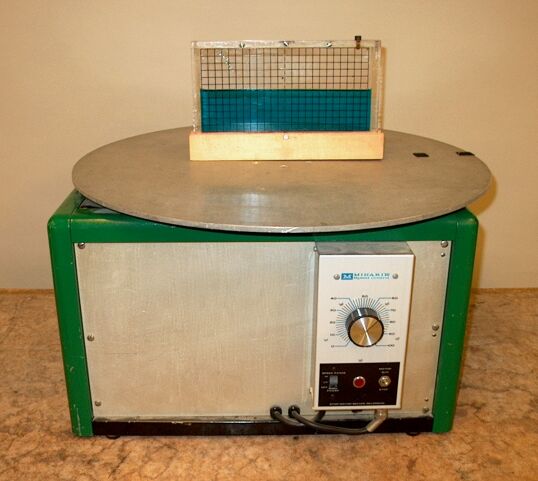
For this demonstration, it is probably best to start with the dial on the turntable control set to zero. Also, it may be useful, before performing the demonstration, to set the accelerometer on the demonstration table, facing the class as shown in the photograph above, and to give it a few quick pushes and pulls along its long axis, to show which way the fluid (colored water) moves in response to a particular acceleration of the cell. Turn on the turntable, and slowly increase the speed. As you increase the speed at which the turntable rotates, the surface of the fluid inside the accelerometer assumes a parabolic shape, which increases in curvature as you further increase the speed of rotation.
When the accelerometer is at rest, the only forces acting on a volume element, of mass m, at the surface of the fluid (colored water) are gravity (= mg, where g is the acceleration of gravity) and the buoyant force of the fluid below, which we may call F, and which balances the force of gravity. These are both perpendicular to the surface of the fluid, which remains horizontal. If we accelerate the cell in the direction of its long axis, there is now a force on the fluid, parallel to its surface. The fluid must flow in such a way as to tilt the surface so that the buoyant force, F, remains perpendicular to the surface, but now has two components – one that balances the force of gravity, and one that provides the acceleration. That is, the fluid assumes an angle θ, relative to the horizontal, such that ma = F sin θ, and mg = F cos θ. If we divide, we find that sin θ/cos θ = a/g, or tan θ = a/g.
In this demonstration, the fluid in the cell experiences a centripetal acceleration, a = ω2r, where ω is the angular speed of the fluid at a particular point, and r is the distance of that point from the center of the circle. (This acceleration also equals v2/r. Since v = ωr, this equals ω2r. See demonstration 16.03 -- Ball on turntable.) So F, again, has a component that balances mg, and one that provides the centripetal force, mω2r. The fluid again must flow to place the surface at an angle, relative to the horizontal, whose tangent is the ratio of these two components, mω2r/mg. We see that the centripetal force varies with the radius, r. If, relative to the height of the fluid surface at the center, we call the height of the surface of the fluid at any other point in the cell z, then the slope of the surface at any point is dz/dr, and tan θ = dz/dr = mω2r/mg = (ω2r/g). If we integrate to find z, we have z = (ω2r2)/2g, or z = (ω2/2g)r2. This is the equation of a parabola.
References:
1) Berg, Richard E. American Journal of Physics 58, 280 (1990).
2) Arbor Scientific, Liquid Accelerometer Instructional Guide.
3) Sundström, Andréas and Adawi, Tom. Physics Education 51 053004(2016).